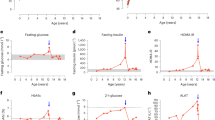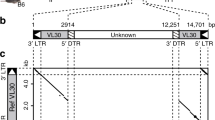Abstract
Agouti protein, a paracrine signaling molecule normally limited to skin, is ectopically expressed in lethal yellow (Ay) mice, and causes obesity by mimicking agouti-related protein (Agrp), found primarily in the hypothalamus. Mouse attractin (Atrn) is a widely expressed transmembrane protein whose loss of function in mahogany (Atrnmg-3J/ Atrnmg-3J) mutant mice blocks the pleiotropic effects of Ay. Here we demonstrate in transgenic, biochemical and genetic-interaction experiments that attractin is a low-affinity receptor for agouti protein, but not Agrp, in vitro and in vivo. Additional histopathologic abnormalities in Atrnmg-3J/Atrnmg-3J mice and cross-species genomic comparisons indicate that Atrn has multiple functions distinct from both a physiologic and an evolutionary perspective.
This is a preview of subscription content, access via your institution
Access options
Subscribe to this journal
Receive 12 print issues and online access
$209.00 per year
only $17.42 per issue
Buy this article
- Purchase on Springer Link
- Instant access to full article PDF
Prices may be subject to local taxes which are calculated during checkout







Similar content being viewed by others
References
Jackson, I.J. Molecular and developmental genetics of mouse coat color. Annu. Rev. Genet. 28, 189–217 (1994).
Millar, S.E., Miller, M.W., Stevens, M.E. & Barsh, G.S. Expression and transgenic studies of the mouse agouti gene provide insight into the mechanisms by which mammalian coat color patterns are generated. Development 121, 3223–3232 (1995).
Willard, D.H. et al. Agouti structure and function: characterization of a potent α-melanocyte stimulating hormone receptor antagonist. Biochemistry 34, 12341–12346 (1995).
Michaud, E.J. et al. A molecular model for the genetic and phenotypic characteristics of the mouse lethal yellow (Ay) mutation. Proc. Natl. Acad. Sci. USA 91, 2562–2566 ( 1994).
Duhl, D.M.J. et al. Pleiotropic effects of the mouse lethal yellow (A(y)) mutation explained by deletion of a maternally expressed gene and the simultaneous production of agouti fusion RNAs. Development 120, 1695–1708 (1994).
Schwartz, M.W., Woods, S.C., Porte, D., Jr., Seeley, R.J. & Baskin, D.G. Central nervous system control of food intake. Nature 404, 661– 671 (2000).
Shutter, J.R. et al. Hypothalamic expression of ART, a novel gene related to agouti, is up-regulated in obese and diabetic mutant mice. Genes Dev. 11, 593–602 (1997).
Ollmann, M.M. et al. Antagonism of central melanocortin receptors in vitro and in vivo by agouti-related protein. Science 278, 135–138 (1997).
Eberle, A.N. The Melanotropins: Chemistry, Physiology and Mechanism of Action (Karger, Basel, 1988).
Cone, R.D. et al. The melanocortin receptors: agonists, antagonists, and the hormonal control of pigmentation. Recent Prog. Horm. Res. 51, 287–318 (1996).
Rosenfeld, R.D. et al. Biochemical, biophysical, and pharmacological characterization of bacterially expressed human agouti-related protein. Biochemistry 37, 16041–16052 ( 1998).
Lu, D.S. et al. Agouti protein is an antagonist of the melanocyte-stimulating-hormone receptor. Nature 371, 799– 802 (1994).
Yang, Y.K. et al. Effects of recombinant agouti-signaling protein on melanocortin action. Mol. Endocrinol. 11, 274– 280 (1997).
Yang, Y.K. et al. Characterization of Agouti-related protein binding to melanocortin receptors. Mol. Endocrinol. 13, 148– 155 (1999).
Graham, M., Shutter, J.R., Sarmiento, U., Sarosi, I. & Stark, K.L. Overexpression of Agrt leads to obesity in transgenic mice. Nature Genet. 17, 273–274 (1997).
Robbins, L.S. et al. Pigmentation phenotypes of variant extension locus alleles result from point mutations that alter MSH receptor function. Cell 72, 827–834 ( 1993).
Huszar, D. et al. Targeted disruption of the melanocortin-4 receptor results in obesity in mice. Cell 88, 131– 141 (1997).
Lane, P.W. & Green, M.C. Mahogany, a recessive color mutation in linkage group V of the mouse. J. Hered. 51, 228–230 (1960).
Miller, K.A. et al. Genetic studies of the mouse mutations mahogany and mahoganoid . Genetics 146, 1407–1415 (1997).
Duke-Cohan, J.S. et al. Attractin (DPPT-L), a member of the CUB family of cell adhesion and guidance proteins, is secreted by activated human T lymphocytes and modulates immune cell interactions. Proc. Natl. Acad. Sci. USA 95, 11336–11341 (1998).
Gunn, T.M. et al. The mouse mahogany locus encodes a transmembrane form of human attractin. Nature 398, 152– 156 (1999).
Nagle, D.L. et al. The mahogany protein is a receptor involved in suppression of obesity. Nature 398, 148– 152 (1999).
Tang, W. et al. Secreted and membrane attractin result from alternative splicing of the human ATRN gene. Proc. Natl. Acad. Sci. USA 97, 6025–6030 (2000).
Ollmann, M.M., Lamoreux, M.L., Wilson, B.D. & Barsh, G.S. Interaction of Agouti protein with the melanocortin 1 receptor in vitro and in vivo. Genes Dev. 12, 316– 330 (1998).
Dinulescu, D.M. & Cone, R.D. Agouti and agouti-related protein: analogies and contrasts. J. Biol. Chem. 275 , 6695–6698 (2000).
Dinulescu, D.M. et al. Mahogany (mg) stimulates feeding and increases basal metabolic rate independent of its suppression of agouti. Proc. Natl. Acad. Sci. USA 95, 12707–12712 (1998).
Lu, X. et al. Distribution of mahogany/attractin mRNA in the rat central nervous system. FEBS Lett. 462, 101– 107 (1999).
Vassar, R., Rosenberg, M., Ross, S., Tyner, A. & Fuchs, E. Tissue-specific and differentiation-specific expression of a human K14 keratin gene in transgenic mice. Proc. Natl. Acad. Sci. USA 86, 1563–1567 (1989).
Mackenzie, M.A., Jordan, S.A., Budd, P.S. & Jackson, I.J. Activation of the receptor tyrosine kinase Kit is required for the proliferation of melanoblasts in the mouse embryo. Dev. Biol. 192, 99– 107 (1997).
Perry, W.L. et al. Coupled site-directed mutagenesis/transgenesis identifies important functional domains of the mouse agouti protein. Genetics 144, 255–264 ( 1996).
Kucera, G.T., Bortner, D.M. & Rosenberg, M.P. Overexpression of an Agouti cDNA in the skin of transgenic mice recapitulates dominant coat color phenotypes of spontaneous mutants. Dev. Biol. 173, 162–173 (1996).
Kiefer, L.L. et al. Mutations in the carboxyl terminus of the agouti protein decrease agouti inhibition of ligand binding to the melanocortin receptors. Biochemistry 36, 2084–2090 (1997).
Jackson, I.J. The mahogany mouse mutation: further links between pigmentation, obesity and the immune system. Trends Genet. 15, 429 –431 (1999).
Fuh, G., Garcia, K.C. & de Vos, A.M. The interaction of neuropilin-1 with vascular endothelial growth factor and its receptor Flt-1. J. Biol. Chem. 275, 26690–26695 (2000 ).
Kawasaki, T. et al. A requirement for neuropilin-1 in embryonic vessel formation . Development 126, 4895– 4902 (1999).
Tsuda, M. et al. The cell-surface proteoglycan Dally regulates Wingless signalling in Drosophila. Nature 400, 276– 280 (1999).
Kitsukawa, T., Shimono, A., Kawakami, A., Kondoh, H. & Fujisawa, H. Overexpression of a membrane protein, neuropilin, in chimeric mice causes anomalies in the cardiovascular system, nervous system and limbs. Development 121, 4309–4318 (1995).
Quistad, G.B. & Skinner, W.S. Isolation and sequencing of insecticidal peptides from the primitive hunting spider, Plectreurys tristis (Simon). J. Biol. Chem. 269, 11098–11101 (1994).
Takeuchi, S., Teshigawara, K. & Takahashi, S. Widespread expression of Agouti-related protein (AGRP) in the chicken: a possible involvement of AGRP in regulating peripheral melanocortin systems in the chicken. Biochim. Biophys. Acta 1496 , 261–269 (2000).
He, Z. & Tessier-Lavigne, M. Neuropilin is a receptor for the axonal chemorepellent Semaphorin III. Cell 90, 739–751 (1997).
Shimizu, M., Murakami, Y., Suto, F. & Fujisawa, H. Determination of cell adhesion sites of neuropilin-1. J. Cell Biol. 148, 1283–1293 (2000).
Little, C.C. The occurence of three recognized color mutations in mice. Am. Nat. 50, 335–349 ( 1916).
Lamoreux, M.L. & Galbraith, D.B. DK/Lm: a strain of laboratory mouse with an unusual expression of the lethal yellow (Ay) phenotype . Genet. Res. 48, 35–40 (1986).
Suto, J., Wakamatsu, K., Yamanaka, H., Ito, S. & Sekikawa, K. Quantitative trait loci that modify the sootiness of yellow pigmentation in KK-A(y)/a mice. Mamm. Genome 11, 639–644 ( 2000).
de Angelis, M.H. et al. Genome-wide, large-scale production of mutant mice by ENU mutagenesis. Nature Genet. 25, 444– 447 (2000).
Van Doren, K., Hanahan, D. & Gluzman, Y. Infection of eucaryotic cells by helper-independent recombinant adenoviruses: early region 1 is not obligatory for integration of viral DNA. J. Virol. 50, 606– 614 (1984).
Gunning, P., Leavitt, J., Muscat, G., Ng, S.Y. & Kedes, L. A human β-actin expression vector system directs high-level accumulation of antisense transcripts. Proc. Natl. Acad. Sci. USA 84, 4831–4835 (1987).
Duke-Cohan, J.S., Morimoto, C., Rocker, J.A. & Schlossman, S.F. A novel form of dipeptidylpeptidase IV found in human serum. Isolation, characterization, and comparison with T lymphocyte membrane dipeptidylpeptidase IV (CD26). J. Biol. Chem. 270, 14107–14114 (1995).
Ollmann, M.M. & Barsh, G.S. Down-regulation of melanocortin receptor signaling mediated by the amino terminus of Agouti protein in Xenopus melanophores. J. Biol. Chem. 274, 15837– 15846 (1999).
Kuramoto, T. et al. Attractin/Mahogany/Zitter plays a critical role in myelination of the central nervous system. Proc. Natl. Acad. Sci. USA (in press).
Acknowledgements
We thank P. Kim and R. Saxena for technical assistance; C. Hwu, M. Ollmann, K. Willert, B. Wilson and J. Xu for advice about experimental design and data presentation; Y. Chen for construction of transgenic mice; P. Budd and I. Jackson for the Dct promoter construct; and H. Lee for assistance with animal breeding and genotyping. This work was supported by grants to G.S.B. (DK-48506) and to S.J.W. (MH42251) from the National Institutes of Health, and by a American Heart Association Western States fellowship award to T.M.G. G.S.B. is an Associate Investigator of the Howard Hughes Medical Institute. L.H. carried out the protein interaction studies and T.M.G. carried out the genetic interaction experiments.
Author information
Authors and Affiliations
Corresponding author
Supplementary information
Web Figure A
Alignment of the complete amino acid alignment of the predicted Atrn proteins encoded by the mouse and Drosophila cDNAs, and by the C. elegans genome sequence. Identities and similarities are shaded in black and gray, respectively, and conserved domains indicated by colored bars. (GIF 83 kb)
Rights and permissions
About this article
Cite this article
He, L., Gunn, T., Bouley, D. et al. A biochemical function for attractin in agouti-induced pigmentation and obesity. Nat Genet 27, 40–47 (2001). https://doi.org/10.1038/83741
Received:
Accepted:
Issue Date:
DOI: https://doi.org/10.1038/83741
This article is cited by
-
Mahogunin Ring Finger 1 regulates pigmentation by controlling the pH of melanosomes in melanocytes and melanoma cells
Cellular and Molecular Life Sciences (2022)
-
Investigation of candidate genes and mechanisms underlying obesity associated type 2 diabetes mellitus using bioinformatics analysis and screening of small drug molecules
BMC Endocrine Disorders (2021)
-
Post-developmental extracellular proteoglycan maintenance in attractin-deficient mice
BMC Research Notes (2020)
-
Mouse models for the central melanocortin system
Genes & Nutrition (2009)
-
New ligands for melanocortin receptors
International Journal of Obesity (2008)



